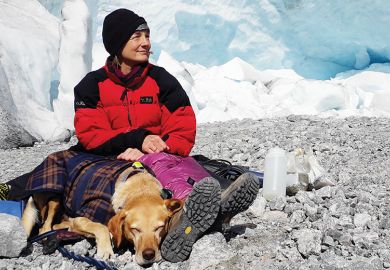Geologists are fond of pointing out that the one thing that gives their subject special status is time. With the exception of cosmologists, who have about three times as much to play with as the 4.5-billion-year history of the earth, geologists have more time than anybody - time to build vast mountain ranges only to be eroded away again, time to fill the ocean basins with water, time to evolve simple organic molecules into writers and reviewers of books. Despite the enormous range of processes that moderate the behaviour of our planet - from the vibration of atoms to the large-scale motion of tectonic plates - most geological and geochemical processes are still understood only from a thermodynamic perspective. The rub here is that the laws of thermodynamics are time-independent. They say nothing about the various pathways that link reactants with their products, or their velocities. This is the preserve of kinetics. In conventional chemistry, kinetic studies are confined mostly to the gaseous state or to reactions in simple solutions. The kinetics of complex natural systems are, to say the least, challenging. This is due in part to their inaccessibility (would you volunteer to measure reaction rates between volcanic gases during an eruption?) but also because of the vast range of timescales over which they operate.
Antonio Lasaga's Kinetic Theory in the Earth Sciences is the first comprehensive review of kinetics in geochemistry. Each of its seven chapters deals with a general aspect of kinetics using examples from nature and the laboratory. Chapter one sets the scene, addressing the fundamentals of rate laws of chemical reactions. Gas behaviour is covered by reference to carbon dioxide kinetics in the atmosphere, while mass transfer during slow (equilibrium) kinetics is dealt with using feldspar dissolution during granite weathering as an example. In an interesting aside, Lasaga discusses briefly the history of temperature-dependent rate reactions. Most physical scientists are so familiar with the equation of Arrhenius (1889) that the idea that there may be other valid expressions relating temperature to reaction rates seems like heresy. But for 60 years, between 1850 and 1910, several rate equations exhibiting a strong temperature dependence were proposed that fitted known experimental kinetic data well. Although they were later shown to lack a sound theoretical basis and disregarded, they remind us that simply applying a mathematical expression to kinetic (or any) data is likely to be flawed unless it is supported by a fundamental theoretical framework.
Transition state theory (TST), a powerful technique that characterises elementary reactions in terms of potential energy barriers, is covered in chapter two. Despite the fundamental statistical mechanics framework on which TST rests, the lack of complete potential energy surfaces for general geochemical reactions is a big drawback. But recent advances in ab initio methods applied to quartz dissolution and the isotopic kinetics of methane appear to offer a way forward. Physical transport of chemical components is the norm in most geological environments, and chapter three is devoted to the kinetics of homogeneous and heterogeneous reactions that can occur during fluid flow. The introduction to the chapter dealing with the importance of conserved properties is a better account than that found in many introductory fluid dynamics texts. Chemical interactions between a migrating fluid and its solid matrix are of special interest in groundwater hydrology and the extraction of silicate melts in the crust and mantle. Useful physical and mathematical definitions of the relevant flow parameters are given, along with numerical solutions for examples involving diffusion and coupled-flow reactions. Diffusion and irreversible thermodynamics are given their own chapters, and the book ends with a detailed discussion of the kinetics of nucleation, crystal growth and dissolution. The text is supported by 83 pages of references that bring together much of what is known about kinetic theory in geochemistry.
Kinetic Theory in the Earth Sciences is impressive in content and scale of investigation. The message seems to be that a proper understanding of time-dependent processes in geology and geochemistry will come about only through the further application of kinetic theory and identification of the reaction pathways involved.
Topics covered in The Earth's Mantle: Composition, Structure and Evolution lie mostly at the large-scale end of kinetic theory. This book brings together a selection of review papers in 11 chapters, written mostly by staff in the Research School of Earth Sciences at the Australian National University. It is arranged into three parts: accretion and differentiation of the earth, dynamics and evolution of the earth's mantle and the structure and mechanical behaviour of the modern mantle, prefaced by a useful summary that highlights areas of broad agreement and controversy.
The chemical composition, origin and evolution of the earth and moon are taken up in the book's first part, which deals with early accretion and differentiation of the earth and atmosphere from a chemical and isotopic perspective. The consensus is that the earth's mantle formed from the solar nebula via heterogeneous accretion, with early core formation followed by addition of a late-stage coating of chondritic material to the mantle. Recent data from "extinct" isotopic systems, particularly 182Hf-182W, constrain core formation to about 50 million years, with major siderophile segregation taking place after final planetary accretion 4.5 billion years ago. Studies of noble-gas isotopes suggest that degassing to form the atmosphere occurred within the first few hundred million years, possibly around the time that the first continental crust enriched in light rare-earth elements formed. Evidence from helium and neon isotopes in basalts from mid-ocean ridges and oceanic islands implies that degassing is still not complete, and that some of the original solar gas component from the earth's formation remains in the lower mantle.
Part two deals with the physical dynamics of the mantle from a numerical and experimental perspective. R. W. Griffiths and J. S. Turner provide an excellent overview of both approaches, followed by two chapters on the physics and chemistry of mantle plumes. The investigation of convective movements within the mantle is reaching new levels of sophistication, due largely to increased computer power and visualisation techniques. Most simulations now are two-dimensional, but it is just a matter of time before three-dimensional models incorporating realistic depth-temperature-dependent rheologies and chemical dynamics are performed. The section ends with an overview of Pyrolite - the name given by A. E. Ringwood to a model mantle composition made up predominantly of olivine and pyroxene.
The final section on structure and mechanical behaviour deals with seismicity and mantle rheology, in particular the ability of rock to fracture and flow. Laboratory experiments are providing crucial data on the various phase transformations that take place in the mantle, and how these may control convection. A long-standing controversy has been whether convection in the mantle occurs in separate layers or as a single unit. Until recently, the two-layered model was favoured, with the boundary between the layers marked by a phase transition at 670km depth. However, recent numerical work suggests that cold, refractory material can periodically sink into the lower mantle, displacing hotter material from the core-mantle boundary into the upper mantle. An important condition is that this style of convection must preserve chunks of mantle as chemically distinct domains on timescales of several billion years. To do this convective mixing in the mantle must be incomplete - more a case of shaken than stirred.
Nick Petford is senior lecturer in geology, Kingston University.
Kinetic Theory in the Earth Sciences
Author - Antonio Lasaga
ISBN - 0 691 03748 5
Publisher - Princeton University Press
Price - £65.00
Pages - 811
Register to continue
Why register?
- Registration is free and only takes a moment
- Once registered, you can read 3 articles a month
- Sign up for our newsletter
Subscribe
Or subscribe for unlimited access to:
- Unlimited access to news, views, insights & reviews
- Digital editions
- Digital access to THE’s university and college rankings analysis
Already registered or a current subscriber?



